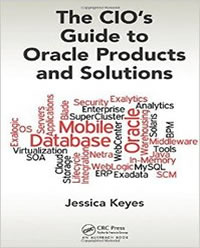SEARCH
Disclaimer: Authors have full rights over their works. Reproduction of any part of the content is prohibited without prior authorization.
BOOK THE CIO-S GUIDE TO ORACLE PRODUCTS AND SOLUTIONS
SUMMARY
-
Items Found: 164
- Chapter 1 Agile PLM 1
- What Is PLM? 2
- Phases of Product Life Cycle 6
- Phase 1: Conceive—Imagine, Specify, Plan, Innovate 7
- Phase 2: Design—Describe, Define, Develop, Test,
- Analyze, and Validate 7
- Phase 3: Realize—Manufacture, Make, Build,
- Procure, Produce, Sell, and Deliver 8
- Phase 4: Service—Use, Operate, Maintain, Support,
- Sustain, Phase Out, Retire, Recycle, and Dispose 9
- Cross Phases 9
- User Skills 10
- Concurrent Engineering 11
- Bottom-Up Design 11
- Top-Down Design 12
- Both-Ends-against-the-Middle Design 13
- Front Loading 13
- Design in Context 14
- Product and Process Life-Cycle Management 14
- PLM Related to Innovation Management 15
- Generating Innovation 17
- Computerized Brainstorming 20
- Sustainable Innovation 24
- The S-Curve and Innovation Management 26
- P-Cycle 27
- What Makes a Business Guru? 29
- Innovation Management at Microsoft 30
- Six Steps for Increasing Creativity and Productivity 34
- Rewarding Employees for Innovative Ideas 38
- Summary 40
- References 41
- Chapter 2 Oracle Analytics: Business Intelligence and
- Analytic Applications 43
- Business Intelligence 45
- Using Information Technology to Gather
- Intelligence 47
- Value of Executive Information Systems 50
- The Science of Gathering Business Intelligence 53
- Checklist for the Information Audit 55
- Selecting What Needs to Be Known 56
- Collecting the Information 56
- Transforming the Collected Information into
- Finished Products 57
- Distributing of the Finished Product to
- Appropriate Staff 58
- Lincoln National Corporation 59
- Competitor Analysis 61
- Automatic Discovery Programs—a.k.a. Data Mining 66
- Data Mining 68
- Data Visualization 70
- Big Data 71
- Summary 74
- References 75
- Chapter 3 Oracle Enterprise Performance Management 77
- Performance Management Fundamentals 92
- Balanced Scorecard 96
- Developing Benchmarks 98
- Plan 100
- Collect 100
- Analyze 101
- Adapt 101
- Analytic Hierarchy Process 104
- Summary 108
- References 111
- Chapter 4 Social Business 113
- Oracle’s Offerings 114
- Why Social Networking 116
- Social Network 120
- Software Engineering Social Network 122
- Collaborative Applications 123
- Social Networking Tools at Work 127
- Tools That Provide Networking Capabilities 127
- Wikis in Action 131
- Semantic Web 133
- Virtual Worlds 135
- Knowledge Management Tools 135
- Summary 139
- References 141
- Chapter 5 Oracle Cloud 143
- Managing the Cloud 151
- Selecting a Cloud Service 152
- CSP and End-User Agreements 154
- Terms of Service Agreements 154
- Nondisclosure Agreements 155
- Service-Level Agreements 155
- Terms and Definitions 155
- Measuring SLA Performance 156
- SLA Enforcement Mechanisms 156
- CSP, Organization, and Integrator Roles and
- Responsibilities 157
- Contracting with Integrators 157
- Clearly Defined Roles and Responsibilities 157
- Standards 158
- Security 158
- Continuous Monitoring 159
- Incident Response 159
- Key Escrow 160
- Forensics 160
- Audit Logs 161
- Privacy Impact Assessments (PIA) 161
- Data Location 162
- Breach Response 163
- Summary 163
- Reference 164
- Chapter 6 Data Management 165
- Oracle and Data Management 174
- Data 178
- Databases 179
- Data Warehouse: Data Marts 179
- Operational Data Store 180
- Data Access 181
- Replication 182
- Resource Management 182
- The Data Warehouse 182
- Source Systems 183
- Data Staging Area 183
- Data Warehouse Database 183
- Data Marts 184
- Extract Transform Load 184
- Business Intelligence (BI) 184
- Metadata and the Metadata Repository 185
- Data Storage Structures 185
- Extraction, Transformation, and Load 187
- Good Data Management Practices 188
- Data Management Roles 188
- Data Sponsor 188
- Data Steward 190
- Data Administration 191
- Database Administration 194
- System Administration and System Support 195
- Data Management Responsibilities 196
- Guidelines 199
- Summary 208
- Chapter 7 Application Development 209
- Principles of Software Engineering 214
- Software Developer 215
- SDLC: Systems Development Life Cycle 217
- Feasibility Study: The First Step 219
- Information-Gathering Channels 219
- Diagramming or Modeling the System 221
- Developmental Methodologies 226
- System Design 229
- Object-Oriented Methodologies 231
- Testing 233
- Installation 236
- Documentation 236
- Maintenance 237
- Training 238
- Summary 238
- Chapter 8 Fusion 239
- Middleware 240
- Applications 247
- Procurement 252
- Making the Outsourcing Decision 252
- Phase 1: Analysis and Evaluation 252
- Phase 2: Needs Assessment and Vendor Selection 254
- Phase 3: Implementation and Management 257
- Procurement Planning 257
- Description of the Project 258
- Market Research 258
- Acquisition Methodology Steps 260
- Procurement Risk Management 262
- Contract Management Approach 262
- Summary 263


